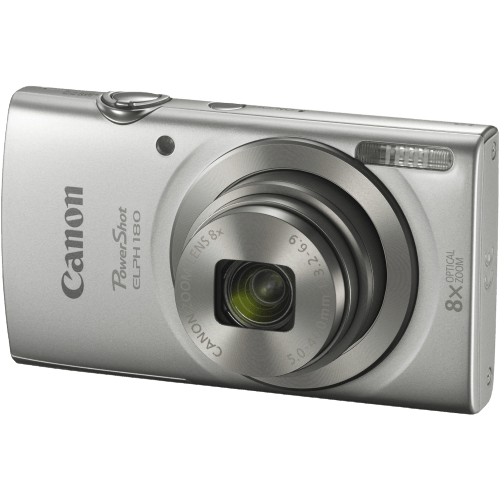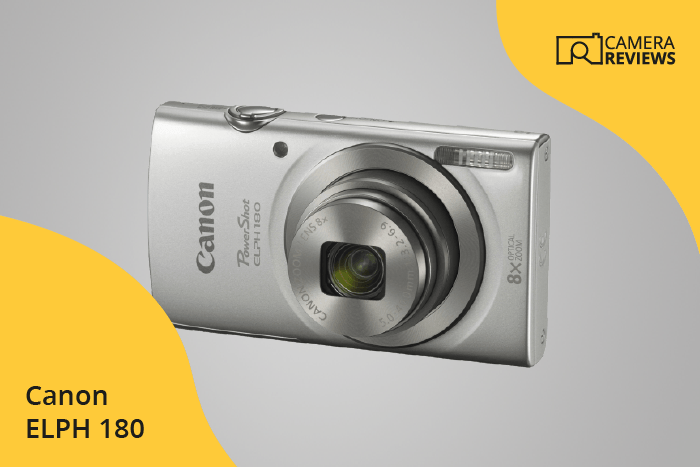Canon PowerShot ELPH 180 Specs and Scores

The Canon PowerShot ELPH 180 receives a score of 46/100. This compact camera was announced on January 5, 2016, and released the same year with a launch price of $120. With dimensions of 95 x 54 x 22mm, it is a small camera that weighs just 126g or 0.28lbs. Considering its age and specifications, the ELPH 180 faces stiff competition in today’s market, as newer models offer more advanced features and better performance.
Canon PowerShot ELPH 180 Overview and Optics
The Canon PowerShot ELPH 180 receives a score of 53/100 for its optics. This compact camera is equipped with a 20-megapixel CCD sensor and a Digic 4+ processor, delivering a shooting speed of 0.8 frames per second. The sensor size is 1/2.3″ and has a DXOMARK score of 66. The aspect ratio of the camera is 4:3, and it features image stabilization.
In comparison to other cameras in today’s market, the ELPH 180’s optics may not be the most advanced or high-performing. The fixed lens mount means users cannot change lenses, limiting versatility. However, the image stabilization feature is a valuable addition, allowing users to capture clearer images and reduce camera shake.
The Canon PowerShot ELPH 180’s optics may not be the top choice for professional photographers, but it is still a decent option for casual users who prioritize simplicity and affordability. The camera’s compact size and easy-to-use features make it suitable for beginners and those seeking a straightforward point-and-shoot experience.
Canon PowerShot ELPH 180 Video Performance
The Canon PowerShot ELPH 180 receives a video score of 34 out of 100. This camera offers standard HD video recording with maximum dimensions of 1280 x 720 pixels. The frame rate for video recordings tops at 30 frames per second, providing decent quality for casual users.
However, these video specifications may not be impressive in today’s market, as many cameras now offer full HD or even 4K video resolutions. Additionally, the PowerShot ELPH 180 lacks time-lapse functionality, which is a popular feature in modern cameras.
Considering these factors, the Canon PowerShot ELPH 180’s video capabilities may fall short for those seeking advanced features or higher quality recordings. This camera is better suited for casual users who prioritize simplicity and affordability over cutting-edge video performance.
Canon PowerShot ELPH 180 Features and Benefits
The Canon PowerShot ELPH 180 holds a feature score of 34/100. Its 2.7-inch screen has a resolution of 230,000 dots, but it does not have a touchscreen or flip screen. While it lacks GPS and Bluetooth capabilities, it does offer Wi-Fi connectivity for sharing photos and videos with ease.
In today’s market, the ELPH 180’s features may appear basic compared to other advanced cameras. However, the Wi-Fi connectivity is a valuable addition that meets the needs of users who prioritize sharing their captured moments.
The ELPH 180’s screen size and resolution are modest but functional, and its absence of GPS, touchscreen, and flip screen features reflects its focus on simplicity. This camera is ideal for those seeking an easy-to-use, no-frills option for capturing memories.
Canon PowerShot ELPH 180 Storage and Battery
The Canon PowerShot ELPH 180 receives a storage and battery score of 27 out of 100. This camera has one memory card slot that accepts SD, SDHC, and SDXC cards, with compatibility for UHS-I. The battery life lasts for 220 shots and uses an NB-11LH battery type. Additionally, the camera supports USB charging.
In the current market, the ELPH 180’s storage and battery capabilities fall short compared to competitors. A battery life of 220 shots is less than ideal for extended use, and the single memory card slot may limit storage capacity for avid photographers. However, the USB charging feature provides convenience for on-the-go users.
Canon PowerShot ELPH 180 Alternatives
Do you want to know how the Canon PowerShot ELPH 180 compares to its competitors? Have a look at the most popular comparisons for this camera below:
- Canon EOS Rebel T100 / 4000D vs PowerShot ELPH 180
- Canon PowerShot ELPH 180 vs PowerShot SX740 HS
- Canon PowerShot ELPH 180 vs Panasonic Lumix DC-G9
- Canon EOS M50 Mark II vs PowerShot ELPH 180
- Canon EOS R7 vs PowerShot ELPH 180
- Canon PowerShot ELPH 180 vs PowerShot SX620 HS
Canon PowerShot ELPH 180 FAQ
Does the Canon PowerShot ELPH 180 Have Built-in Image Stabilization?
Yes, the Canon PowerShot ELPH 180 features built-in image stabilization, which helps reduce blur and camera shake, ensuring sharp and clear images.
Does the Canon PowerShot ELPH 180 Support 4K Video Recording?
No, the Canon PowerShot ELPH 180 does not support 4K video recording. Its maximum video resolution is Standard HD (720p).
What Size Sensor Does The Canon PowerShot ELPH 180 Have?
The Canon PowerShot ELPH 180 is equipped with a 1/2.3″ sensor, which is a common size for compact cameras and offers decent image quality for everyday photography.
Does the Canon PowerShot ELPH 180 Have a Dual Memory Card Slot?
No, the Canon PowerShot ELPH 180 has a single memory card slot, which supports SD, SDHC, and SDXC cards.
Does the Canon PowerShot ELPH 180 Have a Touch Screen?
No, the Canon PowerShot ELPH 180 does not have a touch screen. It features a 2.7-inch LCD screen for image preview and menu navigation.
Does the Canon PowerShot ELPH 180 Have Wi-Fi and Bluetooth?
The Canon PowerShot ELPH 180 has built-in Wi-Fi connectivity, allowing you to easily transfer images to compatible devices. However, it does not have Bluetooth functionality.
Does the Canon PowerShot ELPH 180 Have GPS?
No, the Canon PowerShot ELPH 180 does not have built-in GPS functionality.
Is the Canon PowerShot ELPH 180 Weather Sealed?
No, the Canon PowerShot ELPH 180 is not weather sealed, so it is recommended to protect it from dust, moisture, and extreme temperatures.
Does the Canon PowerShot ELPH 180 Have a Built-in Flash?
Yes, the Canon PowerShot ELPH 180 has a built-in flash, which provides adequate lighting in low-light situations.

